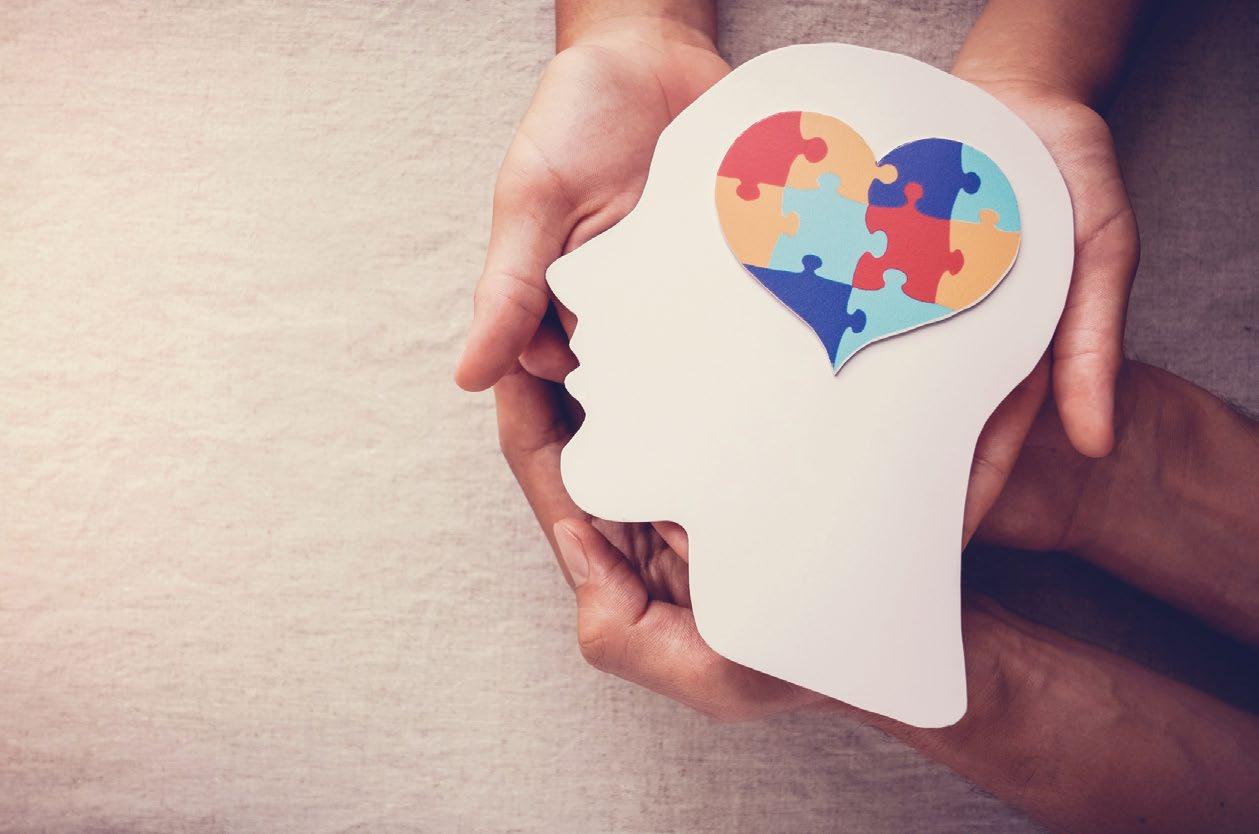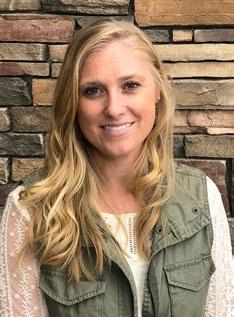
9 minute read
Hope for Mental Health
by Beth McQuinn, ND, Camas Health Clinic
You’re tired, stressed, confused, angry or sad… such seem the signs of these times. The world is a volatile place and there appears to be much to despair over (financial stability, keeping a job, finishing school, and/or food resources), and I want to talk to you about how a change of perspective can turn your experience from one of fear or sadness, to one of hope. “Change” is the only constant in our lives. If we cannot adapt to change, our minds and bodies struggle to be healthy. My medical training taught me that we are made up of a mind, body and soul and if we don’t attend to all three, there can never be full health. We need to constantly battle stress and negativity in our mind in order for our bodies to be healthy. Our bodies are intelligent and maintain a stable environment even in the harshest of conditions. Our system initiates a survival mechanism we affectionately label your “fight or flight” response. It’s our failsafe when it comes to being mentally or physically overwhelmed, but it comes with consequences. Chronic stress (aka, fight or flight response) can cause a miscommunication between the immune system and the hormonal system creating chronic conditions such as chronic fatigue, metabolic disorders (e.g., diabetes, obesity), depression, and immune disorders.2 The effect of chronic stress on the GI tract can be far reaching from radical shifts in gut bacteria to reduction in absorption of nutrients, all of which influence mood and the brain.2 Other effects of long term stress include reduced sex drive, reduced fertility, stomach pain, or heart irregularities. So, how do we “battle” in our minds what appears to be so real? There’s a practice called meditation that has proven to help those with depression and anxiety, equal to medications, if practiced regularly. The definition of meditate is “to train, calm, or empty the mind” or “to engage in contemplation or reflection.”
Advertisement
How often can you honestly say you simply stop and empty your mind? Or is your mind going 90 mph from the moment you wake to the moment your head hits the pillow? Consider this: it’s much easier to maintain control of a car going 30 mph than the one going 90 mph. If you need better control of your mind, it’s time to slow it down a bit and allow space for chaos to come under control. Some practical tips are to buy a small notebook and practice jotting down things you’re grateful for throughout the day. There are many “gratitude journals” for purchase on Amazon and many of the popular “self help” books or authors recommend this practice to get your mind off the negative circumstance, and instead, saturated in all the positives you have going for you! Also, create a consistent time in your busy schedule EACH DAY to stop and clear your mind or at least organize your thoughts. A great resource is “The Miracle Morning” by Hal Elrod which walks you through a morning routine to get your mind and body ready for the day.
A silver lining in the clouds of mental illness is the strength of your community. Mental health is a personal achievement, but family and community health play a large role. So, how is mental health defined? Mental health is “a state of well-being in which every individual realizes his or her own potential, can cope with the normal stresses of life, can work productively and fruitfully, and is able to make a contribution to his or her community.”3 Human beings are social animals and require social interaction to thrive. Get involved in your community and tap into community resources, or better yet, volunteer in your community yourself! Getting the focus off how bad your personal situation is, and helping others rise to their potential, can be a successful climb out of mental negativity or illness.
If you find that you’re not the representation of good mental health and recognize the need for someone outside the home to help you back on the path to mental health, there are accessible and inexpensive resources available:
Health Apps:
• What’s Up: “an amazing free app that uses Cognitive
Behavioral Therapy and Acceptance Commitment Therapy methods to help you cope with Depression, Anxiety, stress and more.”2 • Quit That! “a free app that helps users beat their habits or addictions… whether drinking alcohol, smoking, or taking drugs.”2 • Recovery Record: “a great free app for anyone recovering from an eating disorder and wanting to develop a more positive body image.”2 • Camas Path Behavioral Health Advice Line: 866-270-8603 • Chemical Dependency Clinic (Melissa Hurt-Moran): 509671-4128 or 509-671-6221 • National Suicide Prevention Hotline: 1-800-273-8255 with trained counselors • National Gambling helpline: 1-800-522-4700 • National Domestic Violence Hotline: 1−800−799−7233
Sources: 1https://www.psychologytoday.com/us/blog/balanced/201907/meditation-and-mentalhealth 2https://www.apa.org/topics/stress/body 3Healthypeople.gov/2020/topic-objectives/topic/mental-health-and-mental-disorders 4Top 25 Mental Health Apps: An Effective Alternative for When You Can’t Afford Therapy? Jessica Truschel 5https://www.reuters.com/investigates/special-report/health-coronavirus-usa-cost/?fbcl id=IwAR2rkXY4UPjUvb2aa6P43oEkge7vc3OXd0KdAcKmDBfXazdlXfdE_rHXwq4
Dr. Beth McQuinn is a Naturopathic Physician at Camas Center Clinic in Cusick, WA. In her leisure time, she enjoys nature in the form of hiking, running, equestrian and family activities with her community friends and family. In 2018 she and her husband purchased Bear Paw Camp, thus they move from Western WA to Newport. Beth has an adventurous husband and three busy kids who love life right alongside her.
HOURS
Monday - Wednesday 8am - 5pm Thursday 9am - 5pm

CAMASCENTERCLINIC.ORG
1821 N LeClerc RD, Ste #1 Cusick, WA 99119
The Camas Center Clinic is open to the public and accepts most public and commercial insurances.
DR. MCQUINN, NATUROPATH
Now Accepting New Patients

• General family practice • Herbal / natural prescriptions • Acute care (colds, pain, non-emergency) • Chronic disease care • Wellness exams • Hormone imbalances (men and women) • Weight management • Nutrition counseling • Exercise counseling
APPOINTMENTS: 509.447.7111
Burning and Gritty and Sandy, Oh My!
by Dr. Brayden Petersen, Eye Clinic of Sandpoint
Have you ever wondered why your vision fluctuates during the day? Or, why your eyes sometimes burn, feel sandy or gritty? The answers to these questions stem from one condition that is more common than you may think. The condition I am referring to is known as “Dry Eye.” Some studies point to a prevalence of 50%!
If the visual system is working correctly, all the light rays that enter the eye are bent to focus in one spot on the back of the eye. If all the light rays are focusing in the same spot then we see a clear, single image. If the visual system is broken, the light rays will enter the eye and each light ray will have a different focusing point, thus creating a nonuniform image. This would be perceived as a blurry or distorted image.

Anatomy of the Front of the Eye
To better understand how dry eye changes your vision we need to first understand the anatomy involved. The clear structure on the front surface of the eye is known as the cornea. On the front surface of the cornea is the tear film. The tear film has many functions but one of the more important features is how it bends light. It is often assumed that the cornea or lens has the strongest refractive power (ability to bend light); however, this is only partly true. The tear film also contributes a large portion in the bending of light.
With the tear film contributing so much to our visual clarity, it is important to understand the tear film anatomy. The tear film consists of three layers. The bottom layer is known as the mucous layer and its primary role is to adhere to the cornea. The middle layer is known as the aqueous layer and is comprised mostly of water to keep the eye lubricated. And the very top layer is an oil layer produced by glands in our lids. The purpose of the oil layer is to prevent evaporation of the tear film.
Evaporative Dry Eye
The most common form of dry eye is known as evaporative dry eye. This type of dry eye is when the oil glands in our lids fail to produce enough oil to stabilize the cornea and tear film. If we no longer have oil to prevent the evaporation of our tears, we begin to lose both the top and middle layers simultaneously. When we no longer have those layers we begin to have dry eye symptoms. Not only will the eye begin to feel gritty, sandy, heavy or on fire, but it also causes visual fluctuations.
From our anatomy paragraph we learned that the tear film bends light. When light rays entering the eye hit the areas of dryness, the light rays will bend differently than light rays that hit a lubricated area. If we have two light rays bending in different locations its perceived as a blurry image. And that is the answer to our question. The instability of the tear film causes these visual fluctuations. But there is good news! There are many treatments to help with these symptoms. They include artificial tear programs, dry eye therapies and devices, or topical medications.
Aqueous Deficient Dry Eye
The second type of dry eye is known as aqueous deficient dry eye. This is when the lacrimal gland does not produce enough aqueous layer (the middle layer). Causes of this type of dry eye include Sjogren’s disease, contact lens use, LASIK/ PRK, surgeries, previous infections, or other systemic conditions. This type of dry eye can also cause transient vision for the same reason stated above. Treatments also include topical drops, medications, and management of underlying conditions if applicable.
In realty most dry eye symptoms felt by a patient stem from both types. Treating one would surely help the other. But there is a catch. As our world becomes more digital we are seeing even more strain on the visual system. It has been measured that when we look at screens or read we blink 60% less than we would normally. This alone accounts for the increase in prevalence we are seeing. One could only assume that this trend will continue unless we begin now to protect our visual system.
So, next time you sit down to read or do computer work, are you noticing some blur? If so, you now understand why. If you or anyone you know is suffering from these types of symptoms, we encourage you to give us a call at 208-263-8501. If you would like to learn more please visit our website at www.eyeclinicofsandpoint.com.
Dr. Brayden Petersen earned his Doctorate of Optometry from Pacific University College of Optometry. He gained advanced training at the Forest Grove Pediatric Clinic, Salt Lake City Veterans Hospital and Eye Institute of Utah. During this time, he specialized in the treatment of ocular disease, contact lenses and comanagement of ocular surgeries. Dr. Brayden enjoys talking with his patients about their eyes. He believes in not only discussing the treatment plan but also wants his patient to understand “why” the condition occurs and provides the most comprehensive exam possible with the most up to date technology available.


